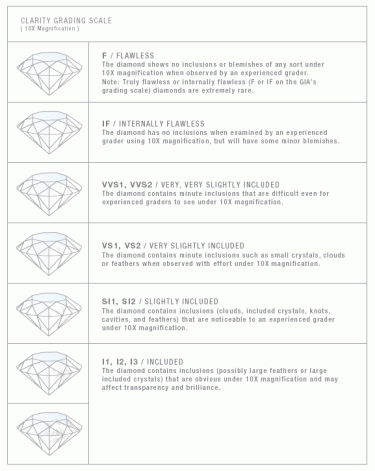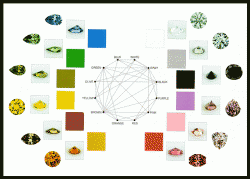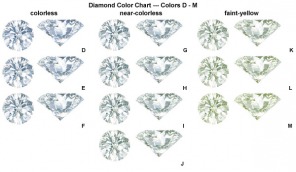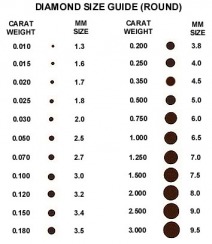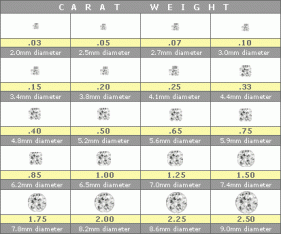1.Clarity
Clarity
Clarity is the evaluation of a diamond's internal and external characteristics. The fewer inclusions or blemishes, the more desirable the diamond. Inclusions are internal, that is, inside the diamond. Two of the most common inclusions are crystals and feathers. Crystals are merely minerals trapped inside the diamond; feathers are breaks in the diamond. Blemishes are usually very small and are only on the surface of diamonds. To locate these tiny characteristics, an American Gem Society member jeweler will use a binocular microscope that magnifies the diamond ten times. Then, evaluating the size, location, nature, number, and color of all the inclusions and blemishes, a clarity grade from 0-10 is assigned. Zero represents a diamond that is free of any inclusion or blemish when examined by a skilled grader under 10x magnification and proper lighting…Read here for more
Clarity is the evaluation of a diamond's internal and external characteristics. The fewer inclusions or blemishes, the more desirable the diamond. Inclusions are internal, that is, inside the diamond. Two of the most common inclusions are crystals and feathers. Crystals are merely minerals trapped inside the diamond; feathers are breaks in the diamond. Blemishes are usually very small and are only on the surface of diamonds. To locate these tiny characteristics, an American Gem Society member jeweler will use a binocular microscope that magnifies the diamond ten times. Then, evaluating the size, location, nature, number, and color of all the inclusions and blemishes, a clarity grade from 0-10 is assigned. Zero represents a diamond that is free of any inclusion or blemish when examined by a skilled grader under 10x magnification and proper lighting…Read here for more
2. Color
Color
A truly colorless diamond is extremely rare. Most diamonds possess varying degrees of yellow or brown and small, subtle differences in color can make a substantial difference in value. Although increasing shades of yellow can reduce the value of a diamond this does not necessarily reduce its beauty. If a diamond is well cut, the diamond's refraction and dispersion often will disguise certain degrees of coloration. Unless a diamond is a fancy color (or any color other than colorless to light yellow or brown), the American Gem Society Color Grading System places it on a 0 to 10 scale, 0 being colorless. To accurately and consistently grade color, an American Gem Society trained grader will utilize special lighting to compare the diamond being graded to a set of American Gem Society Master Color Comparison Diamonds, which have met exacting standards of cut, color, clarity, and carat weight. The diamond is viewed face down and reassessed face-up for the most accurate and consistent grade.…Read here for more
A truly colorless diamond is extremely rare. Most diamonds possess varying degrees of yellow or brown and small, subtle differences in color can make a substantial difference in value. Although increasing shades of yellow can reduce the value of a diamond this does not necessarily reduce its beauty. If a diamond is well cut, the diamond's refraction and dispersion often will disguise certain degrees of coloration. Unless a diamond is a fancy color (or any color other than colorless to light yellow or brown), the American Gem Society Color Grading System places it on a 0 to 10 scale, 0 being colorless. To accurately and consistently grade color, an American Gem Society trained grader will utilize special lighting to compare the diamond being graded to a set of American Gem Society Master Color Comparison Diamonds, which have met exacting standards of cut, color, clarity, and carat weight. The diamond is viewed face down and reassessed face-up for the most accurate and consistent grade.…Read here for more
3.Cut
Cut
Of all the 4 Cs, cut has the greatest effect on a diamond's beauty. In grading, cut evaluates the cutters skill in the fashioning of the diamond. Diamonds have a unique ability to manipulate light efficiently. This unique ability can be released and maximized only by cutting and polishing the diamond to an extremely high level of accuracy. This also requires that the cutters be willing to put forth a great deal of time and effort, adhere to some very strict geometric standards and, most important, be willing to sacrifice carat weight for superior craftsmanship. The American Gem Society Cut Grading System considers not only the proportions of a diamond, but also the craftsmanship of its overall symmetry and polish. It is unique in that it uses the latest in technology to analyze the cut’s impact on the diamond’s light performance…Read here for more
Of all the 4 Cs, cut has the greatest effect on a diamond's beauty. In grading, cut evaluates the cutters skill in the fashioning of the diamond. Diamonds have a unique ability to manipulate light efficiently. This unique ability can be released and maximized only by cutting and polishing the diamond to an extremely high level of accuracy. This also requires that the cutters be willing to put forth a great deal of time and effort, adhere to some very strict geometric standards and, most important, be willing to sacrifice carat weight for superior craftsmanship. The American Gem Society Cut Grading System considers not only the proportions of a diamond, but also the craftsmanship of its overall symmetry and polish. It is unique in that it uses the latest in technology to analyze the cut’s impact on the diamond’s light performance…Read here for more
4.Carat (weight)
Carat (weight)
Comparing the value of stones by weight is like comparing the value of paintings by size. A wall-sized canvas by an unskilled artist may be bigger than a miniature by Rembrandt, but it will not be worth more. The standard used to measure diamond weight is the carat. A carat equals 1/5 of a gram (or 1/142 of an ounce). Each carat is further divided into points, each point representing 1/100th of a carat. While weight may be the least important of the four Cs in determining value, it may be the easiest of the four Cs to gauge accurately and is the most objective. All that is required is a delicately balanced scale capable of weighting extremely small weights. Yet, despite the ease of measurement and the relative unimportance of diamond weight, there are some facts you should understand about weight and price.
First, as diamonds increase in size, their cost tends to increase geometrically rather than arithmetically. Thus, a one-carat diamond may cost more than twice as much as a one-half carat stone of equal quality. Also, as previously stated, weight does not always enhance the value of a diamond. In fact, when a stone is improperly cut, added weight may serve only to reduce its brilliance. For these reasons, you should consult with an American Gem Society titleholder or individual regarding the question of carat weight, especially as it relates to the quality of the diamond's cut. …Read here for more
Comparing the value of stones by weight is like comparing the value of paintings by size. A wall-sized canvas by an unskilled artist may be bigger than a miniature by Rembrandt, but it will not be worth more. The standard used to measure diamond weight is the carat. A carat equals 1/5 of a gram (or 1/142 of an ounce). Each carat is further divided into points, each point representing 1/100th of a carat. While weight may be the least important of the four Cs in determining value, it may be the easiest of the four Cs to gauge accurately and is the most objective. All that is required is a delicately balanced scale capable of weighting extremely small weights. Yet, despite the ease of measurement and the relative unimportance of diamond weight, there are some facts you should understand about weight and price.
First, as diamonds increase in size, their cost tends to increase geometrically rather than arithmetically. Thus, a one-carat diamond may cost more than twice as much as a one-half carat stone of equal quality. Also, as previously stated, weight does not always enhance the value of a diamond. In fact, when a stone is improperly cut, added weight may serve only to reduce its brilliance. For these reasons, you should consult with an American Gem Society titleholder or individual regarding the question of carat weight, especially as it relates to the quality of the diamond's cut. …Read here for more
Watch the video below to know more of 4 C's of Diamonds
